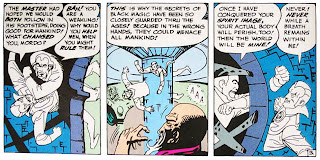What we are reading: Iron Man Vs Kala, Queen of the Netherworld- Tales of Suspense#43
 |
| The Spandex Iron Man |
When reading through the Silver Age establishment of the Marvel universe you get to see both the very illuminating stories that set up beloved characters and the utterly atrocious, politically backward hogwash, which permeated the comics and the zeitgeist of the period. This Iron Man story is the latter.
Before jumping into the negatives of this story let’s examine the one positive: the Atlanteans make their first appearance in this one. They are, in later arcs, subterranean threats that are in many ways apocalyptic. Here, though, their motives are flat and really not examined thoroughly. They want to take over Earth because they are angry that a geological event sank their empire. Let’s get revenge on humanity which runs volcanos or something. I don’t know. Even the one positive makes little sense. That being said, this story is a mess. Not only because it espouses backwards Sixties morals but because arc-wise, it has none.
The story begins at Stark Industries in the middle of a wind tunnel test. The tunnel stops working and turns the station into a veritable hurricane. Stark calls down and explains luckily by happenstance Iron Man is visiting the factory so he can save the windblown scientists. It is flimsy excuses like this that no doubt caused Anthony and Stan to strip the facade later. It’s an excessively obvious and convenient piece of writing; so unintelligent a moment that it doesn’t even pass as charming camp.
After this minor incident of blowhardism at the wind tunnel, Tony climbs into his spandex iron suit and gets sucked into the center of the Earth. Sidebar: The Iron suit in this one is actually depicted as a spandex body suit. It’s stupidity like this that shows you Jack “I don’t care for plausibility” Kirby is back at the artistic helm. When Tony arrives in the in the centre of the Earth he and his spandex iron suit are embroiled in a hastily thought out thousand year old plan to take over the surface. We soon find out that Supreme General Blaxu resents taking orders from the female ruler Kala. Tony concurs and he flies her off to the surface where she sees her complexion age in seconds. Iron Man tells her that if she wants her beauty she should stay underground. She does for “what is a women without her beauty.”
This story is disgusting. A female leader that cares so much for her looks that she abandons her long held goal and just to nail another has to be one grossest example of female stereotype. Just to nail another peg into the chauvinist coffin Tony tells Blaxu to marry Kala so that she has proper guidance.
‘Women can’t lead, young Marvelites. They need a man.’
No wonder Sue Storm can’t get a shred of decent dialogue.
I know chauvinism has always been a part of Tony Stark, as he is a millionaire playboy with the face of Errol Flynn after all, but in later stories he is usually offset with a strong female to take him to task. It also may be unfair of me to judge a story written in a vastly different time by the ethics of today, but the sad thing is, that even under all the sexism this story is poorly constructed and frankly worthless. Nothing feels connected and no character really sticks out a vital or interesting. It feels like hastily written filler.
At least Jack Kirby has started to draw backgrounds. That’s a plus.
0 out of 5.





